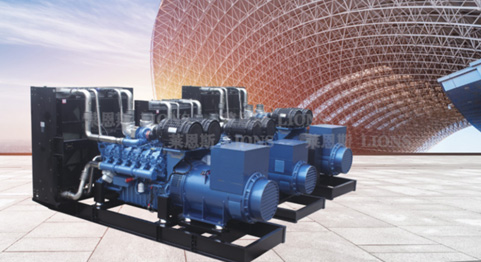Where does the noise of diesel generator set come from?
2021-10-22
1. Exhaust noise:
Exhaust is a kind of pulsating air flow noise with high temperature and high speed. It is the most energy and component part of engine noise. It is much higher than the intake noise and the mechanical noise radiated by the engine body. It is the most important part of the total engine noise. Its fundamental frequency is the firing frequency of the engine. The main components of exhaust noise are as follows: low frequency pulsation noise caused by periodic exhaust, gas column resonance noise in exhaust pipe, Helmholtz resonance noise of cylinder, noise generated by high-speed air flow passing through valve clearance and tortuous pipe, eddy current noise, and regeneration noise generated by exhaust system under pressure wave excitation in pipe, etc, With the increase of air velocity, the noise frequency increases significantly.
2. Mechanical noise:
The mechanical noise is mainly caused by the vibration or mutual impact of the moving parts of the engine caused by the periodic changes of gas pressure and motion inertia force during operation, of which the most serious are the following: the noise of piston crank connecting rod mechanism, the noise of valve mechanism, the noise of transmission gear, the mechanical vibration and noise caused by unbalanced inertia force. The strong mechanical vibration of diesel generator set can be transmitted to outdoor places through the foundation, and then form noise through the radiation of the ground. This structure has long noise propagation and reduced attenuation. Once formed, it is difficult to isolate.
3. Combustion noise:
Combustion noise is the structural vibration and noise produced by diesel during combustion. The sound pressure level of combustion noise in the cylinder is very high. However, most parts in the engine structure have high rigidity, and their natural vibration frequencies are mostly in the medium and high frequency region. Due to the mismatched response to the sound wave propagation frequency, the peak value of high cylinder pressure level in the low frequency band can not be transmitted smoothly, while the cylinder pressure level in the medium and high frequency band is relatively easy to be transmitted.
4. Cooling fan and exhaust noise:
The fan noise of the unit is composed of eddy current noise and rotating noise. The rotating noise is caused by the periodic disturbance of the blade cutting air flow of the fan; Vortex noise is generated when the air flow separates on the rotating blade section. The vortex flow caused by the viscosity of the gas radiates an unstable flow noise. Exhaust noise, air flow noise, fan noise and mechanical noise are radiated through the exhaust channel.
5. Air inlet noise:
The diesel generator set needs enough fresh air supply during normal operation. On the one hand, it is necessary to ensure the normal operation of the engine, on the other hand, it is necessary to create good heat dissipation conditions for the unit, otherwise the unit cannot guarantee its service performance. The air inlet system of the unit basically includes the air inlet channel and the air inlet system of the engine itself. The air inlet channel of the unit must enable the fresh air to enter the machine room smoothly. At the same time, the mechanical noise and air flow noise of the unit can also be radiated outside the machine room through this air inlet channel.
6. Generator noise:
Generator noise includes electromagnetic noise caused by magnetic field pulsation between stator and rotor and mechanical noise caused by rolling bearing rotation.
According to the above noise analysis of diesel generator set. Generally, the following two treatment methods are adopted for the noise of generator set:
The noise reduction treatment or purchase of the oil engine room shall adopt the sound proof unit (the noise is 80dB --- 90dB)
Exhaust is a kind of pulsating air flow noise with high temperature and high speed. It is the most energy and component part of engine noise. It is much higher than the intake noise and the mechanical noise radiated by the engine body. It is the most important part of the total engine noise. Its fundamental frequency is the firing frequency of the engine. The main components of exhaust noise are as follows: low frequency pulsation noise caused by periodic exhaust, gas column resonance noise in exhaust pipe, Helmholtz resonance noise of cylinder, noise generated by high-speed air flow passing through valve clearance and tortuous pipe, eddy current noise, and regeneration noise generated by exhaust system under pressure wave excitation in pipe, etc, With the increase of air velocity, the noise frequency increases significantly.
2. Mechanical noise:
The mechanical noise is mainly caused by the vibration or mutual impact of the moving parts of the engine caused by the periodic changes of gas pressure and motion inertia force during operation, of which the most serious are the following: the noise of piston crank connecting rod mechanism, the noise of valve mechanism, the noise of transmission gear, the mechanical vibration and noise caused by unbalanced inertia force. The strong mechanical vibration of diesel generator set can be transmitted to outdoor places through the foundation, and then form noise through the radiation of the ground. This structure has long noise propagation and reduced attenuation. Once formed, it is difficult to isolate.
3. Combustion noise:
Combustion noise is the structural vibration and noise produced by diesel during combustion. The sound pressure level of combustion noise in the cylinder is very high. However, most parts in the engine structure have high rigidity, and their natural vibration frequencies are mostly in the medium and high frequency region. Due to the mismatched response to the sound wave propagation frequency, the peak value of high cylinder pressure level in the low frequency band can not be transmitted smoothly, while the cylinder pressure level in the medium and high frequency band is relatively easy to be transmitted.
4. Cooling fan and exhaust noise:
The fan noise of the unit is composed of eddy current noise and rotating noise. The rotating noise is caused by the periodic disturbance of the blade cutting air flow of the fan; Vortex noise is generated when the air flow separates on the rotating blade section. The vortex flow caused by the viscosity of the gas radiates an unstable flow noise. Exhaust noise, air flow noise, fan noise and mechanical noise are radiated through the exhaust channel.
5. Air inlet noise:
The diesel generator set needs enough fresh air supply during normal operation. On the one hand, it is necessary to ensure the normal operation of the engine, on the other hand, it is necessary to create good heat dissipation conditions for the unit, otherwise the unit cannot guarantee its service performance. The air inlet system of the unit basically includes the air inlet channel and the air inlet system of the engine itself. The air inlet channel of the unit must enable the fresh air to enter the machine room smoothly. At the same time, the mechanical noise and air flow noise of the unit can also be radiated outside the machine room through this air inlet channel.
6. Generator noise:
Generator noise includes electromagnetic noise caused by magnetic field pulsation between stator and rotor and mechanical noise caused by rolling bearing rotation.
According to the above noise analysis of diesel generator set. Generally, the following two treatment methods are adopted for the noise of generator set:
The noise reduction treatment or purchase of the oil engine room shall adopt the sound proof unit (the noise is 80dB --- 90dB)










